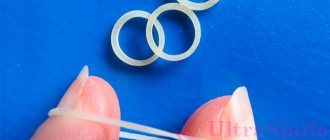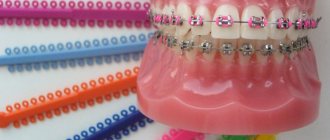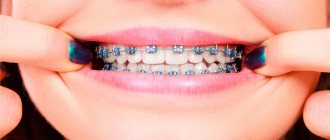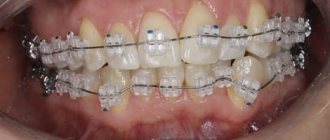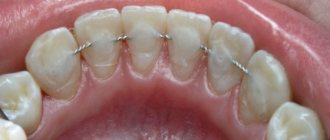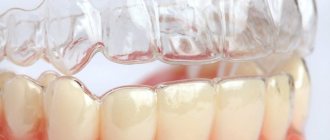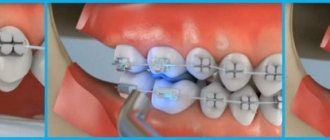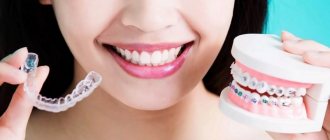July 15, 2021
In the process of correcting malocclusion with braces, some patients require additional elements to be installed on their teeth. Most often, elastics are fixed, which do not look as attractive and unnoticeable as we would like. Plus, some admit that with rubber bands they have to go through a new series of unpleasant sensations. What is this? How long? What are the features of installation and operation? What should you pay attention to? We'll talk about this in an article on the UltraSmile.ru portal.
What are elastics
Elastics, or as they are also called, rods for braces, are auxiliary devices, the purpose of which is to increase the impact on a specific tooth or group of teeth, to align the elements of the upper and lower jaw relative to each other. And thereby achieve an ideal result not only aesthetically, but also functionally. They look like ordinary small round rubber bands. Can be colored or transparent. Made from durable yet highly stretchable surgical latex.
Elastics are small round rubber bands made from durable but highly stretchable surgical latex.
It is important to understand that pulls are not the same as ligatures, although they are similar in appearance. The second, that is, ligatures, are an integral part of the ligature bracket system, where a metal power arc is attached to the grooves using ligatures (small rubber bands). They must be worn throughout the entire treatment period, and the doctor changes them every 2-4 weeks. But with elastic cords for braces, the situation is somewhat different.
What patients can do on their own
The patient can remove and install elastic cords independently, provided that the doctor has explained exactly how to carry out the fixation technique. Inserting an elastic band between your teeth in front of a mirror is not enough - you need to know which teeth the rods should cling to and not make your own decisions about attaching the elastics in front of braces.
Important!
Some people are embarrassed by the appearance of elastics and pull-ups, so they deliberately wear them for less time, taking them off before leaving the house or for photos. In this case, it is impossible to achieve quick and successful results, since elastic bands for braces are needed in order to improve the results of treatment.
Indications for installation
- the presence of impacted teeth and the need to pull them into the dentition after freeing up additional space in the jaw,
- the need to align the jaws relative to each other or pull the upper jaw towards the lower so that they close normally (for example, with an open bite),
- the presence of a tooth protruding from the row: then it needs to be displaced,
- single interdental spaces, lack of contact between row elements.
Elastics have a constant impact on an individual tooth or group of teeth and, in fact, perform the same function as a power arc, but only more precisely and purposefully.
Elastics have a permanent effect on an individual tooth or group of teeth.
Types of traction
Today, braces manufacturers create elastics that differ in the following characteristics:
- elasticity, hardness: weak, medium, medium-strong, strong, super strong,
- length: short ones connect small areas, long ones connect groups of teeth,
- extraoral and intraoral: the former are used to treat mesial occlusion in combination with a facebow, the latter are used specifically for aligning elements in the oral cavity (most often they are what we are talking about).
To make it easier for doctors, and subsequently patients, to navigate the varieties, manufacturers produce rods in packages with the names of different animals or countries. Thus, the well-known company Ormco, which creates braces of the Damon series, produces a series of intermaxillary rods “Zoo”, where there are sets of “beaver”, “bull”, “camel”, “giraffe”, “penguin”, “ostrich” and others .
Damon series braces
Types of rubber bands
During the treatment process, the specialist can use different types of elastics, each of which has its own functional significance.
Elastic traction
We are talking about rings that are put on braces installed on both the upper and lower teeth. During fixation, the doctor ensures that the tension remains at an optimal level and is not too weak or too strong.
On a note!
These are the only elastics for braces that the patient can remove or put on independently, without the participation of a specialist.
The intermaxillary traction created is indicated for correcting malocclusion and uneven teeth at the end of the course of treatment. Elastic cords from Ormco, 3M Unitec and other manufacturers are popular.
Ligature rubber bands
These are small-diameter rings that are installed on each bracket to combine the plates with the arch into a single structure. They are used in ligature systems and are offered in various colors.
Multi-colored orthodontic rubber bands make the process of correcting uneven teeth more interesting for children and teenagers. Only a specialist fixes and removes ligature rings. Common brands of quality products:
- G&H Orthodontics;
- American Orthodontics;
- 3M Unitek.
Chain rings
Such rings are connected alternately, forming a kind of monochain. Rubber bands of this type are used to tighten teeth, that is, to eliminate wide interdental spaces.
A doctor must put chain rings on braces. The specialist fixes each rod in problem areas, and then connects them into a single chain using additional devices. Popular manufacturers:
- Ormco;
- Ortho Technology;
- 3M Unitec.
How to secure the rods
Initially, the installation of rods for braces is carried out by an orthodontist. He carefully threads them into special hooks located on the plates of the bracket systems. However, elastics can be fixed in the oral cavity in different ways:
- V-shaped: the elastic band is tightened on two teeth of one jaw and one element of a row of the other jaw. As a rule, it solves the issue of moving one unit, or helps to give two units a normal location relative to each other,
- box-shaped: after installation, the elastic takes on a square or rectangular shape. Responsible for moving and aligning an entire group of row elements.
Regardless of the installation method, elastics are always fixed on both jaws at once. Their location can be different: for example, they can connect the lower “sixes” and the upper “twos” or “fours”. In this case, a certain symmetry is always maintained due to the same tension force, which allows the load to be evenly distributed. Therefore, if one rubber band suddenly breaks, for example, on the right, then it is necessary to replace both rods.
After installation, the doctor must give you a special tool with a hook on the end and a “slingshot” on the other side, as well as a diagram of how to properly fix the elastic bands. After all, the patient will subsequently have to independently remove and put on the braces.
Mounting methods
Many patients are interested in how to properly put elastic bands on braces. Only an orthodontist can answer this question correctly. It is he who fixes them, calculating the tension force of each element in order to achieve optimal treatment results in a short time without risk to the teeth.
There are two main ways to install rubber bands on braces:
- V-shaped - after fixation, the elastic looks like a tick due to the fact that on one jaw it is attached to two plates, on the second - to one;
- Box-shaped - after attachment, the elastic resembles the shape of a quadrangle, covering a significant area of the teeth on both jaws at once.
On a note!
Depending on what malocclusions and tooth position are diagnosed in the patient, the doctor can use both types of fastenings at the same time.
How long to wear, when to take off
Depending on the period of operation, everything is very individual. Some patients wear elastics for 1-2 months, others for 4-6 months. But there are also those who go with them for more than six months.
The wearing pattern is also determined individually. At first, some people need to remove braces only when eating and for oral hygiene. Others wear them mainly at night, or for 12-16 hours a day.
“Oh, my elastics were installed in a zigzag pattern on the right and left. When it was first installed, I felt terrible pressure, especially at night. It even seemed as if the teeth were grinding, they were pulled together so tightly. And then I didn’t notice how I got used to it. The elastic bands stretch very quickly, and then you don’t even notice! I even tried to eat in them later, but I don’t recommend it to others, it could cause them to burst...” Masyanya, review from the forum breketi.3bb.ru
The pattern of wearing elastics is determined individually
What inconveniences should you prepare yourself for?
You won't be able to chew food while wearing elastics, so you'll have to take them off for snacks. Moreover, if they are installed correctly, the patient usually does not have serious problems opening his mouth when speaking. But at first, many people, of course, feel discomfort from the new state of things in the mouth, soreness, and tightness.
Some patients admit: at first it seems that in this form and with their jaws pulled together it will be impossible to go to work, communicate with colleagues and friends. But in reality everything is different. Most quickly get used to it and feel quite at ease.
The rods for braces have one feature - they stretch quickly and therefore can fly off. Sometimes they also tear. So that they fully perform their function, and you “suffer” for good reason, be sure to change them. Doctors usually recommend replacing 2 times a day, morning and evening. Therefore, you need to always have a set of rubber bands at home. But there are usually no problems with stocks, because elastics are sold in sets of 100 pieces and are quite inexpensive.
You should not increase or decrease the number of elastic bands. There is no need to attach them to other areas unless prescribed by the orthodontist. Strictly follow all recommendations prescribed by your doctor, do not despair at the initial stage of possible discomfort and do not relieve cravings. And then a positive result will not be long in coming.
Notice
: Undefined variable: post_id in
/home/c/ch75405/public_html/wp-content/themes/UltraSmile/single-item.php
on line
45 Notice
: Undefined variable: full in
/home/c/ch75405/public_html/wp-content /themes/UltraSmile/single-item.php
on line
46
Rate this article:
( 2 ratings, average: 5.00 out of 5)
- According to the official website ormco.ru
Expert “In terms of size, the elastics seem very small, and in terms of elasticity, they seem too elastic. And many patients are perplexed about how they will put traction on braces. However, in reality, everyone eventually learns this too. A couple of attempts in front of the mirror, and then the desired skill appears, and the rubber bands are fixed in literally 2-3 minutes. A special tool helps a lot in quick fixation.” Orthodontist Vagapov Zakir Irkinovich
Consulting specialist
Vagapov Zakir Irkinovich
Doctor rating: 7 out of 10 (3) Specialization: Orthodontist Experience: 16 years
Why do you need traction on braces?
Pulls are elastic bands of small diameter that are worn after braces are placed. They are needed to correct the position of the teeth depending on the severity of the situation. If they are installed correctly, the patient does not feel discomfort when wearing them. Wearing braces and orthodontic bands requires following the dentist's instructions and certain restrictions.
Elastics come in several types and vary in thickness, diameter and length; they fix small areas of the system and additionally correct the smile. The doctor must determine which rubber bands are suitable for a particular malocclusion pathology, and install them independently, explaining to the patient what results and after how long to expect. After a certain period, the rubber loses its elasticity and ceases to create pressure properly. In this case, you should contact an orthodontist who will replace the old rods with new ones.
